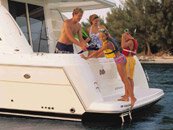A: No matter where you live, the quickest way to find out about racing activities is to find a sailor. Most any sailor can refer you to another sailor who races and will be able to fill you in on racing in the area. You can also learn a lot on the internet through US SAILING (ussailing.org) and whichever regional sailing association is closest to you. There are more than 35 regional sailing associations, with names like Gulfcoast Sailing Association or Narragansett Bay Yacht Racing Association, and they are organizations of yacht and sailing clubs in an area. Through their websites you can read racing schedules, see which clubs race the most, and learn about the types of boats that are raced. You’ll also find all sorts of contact info so you can follow up further.
Q: How can a new sailor get involved in racing – what are the options?
A:You may be interested, ultimately, in sailing in long-distance races or in high-speed skiff sailing, but the place to start to learn about racing is in low-key races, often held in the evening when the winds are light and everyone is relaxed. To get connected, besides doing some research on the internet and following up with the various associations and clubs, I recommend contacting public-access sailing groups, sailing schools, or simply finding out where the racers are and showing up on the dock to see if you can help out as a crew. Boat owners are always looking for enthusiastic crewmembers. You can also search on the web for “sailing crew lists” in your area; these are electronic bulletin boards where you can post your name and state your abilities and interests. One other important point is that if you’re interested in racing in a particular type of boat, contact the class association (again, it will have a website) to find out where it’s raced in your vicinity.
Q: What are the benefits of becoming involved in local racing and sailing activities?
A: Sailing is a lifetime sport, with racers often competing into their 80s. There are a variety of boat types so you can choose from boats that demand a high degree of fitness to those that are very relaxing. The competition, in either case, is stimulating and draws you outdoors to enjoy and appreciate a natural environment in the company of friends and friendly competitiors. You become part of a worldwide community of enthusiasts sharing a love for a sport that’s fresh and new every time you race and yet you’re part of a tradition that dates back nearly 200 years.
Q: What are the costs associated with local racing activities?
A: As a crewmember on someone else’s boat, your expenses can be quite modest. Public sailing associations are cheap to join and often have boats to use or rent, and most private yacht clubs are far less expensive than, for example, golf clubs. If you do buy your own boat, it can cost anywhere from $1000 to whatever you have the means to spend. Almost anyone can find a racing level that fits their budget.
Q: What special equipment or gear is needed?
A: Depending on the climate where you live, you may need to buy good foul weather gear and boots, plus special mid-layers of clothing to keep you warm and dry. In milder seasons, the demands on this personal gear become less, but at a minimum you’ll probably need to purchase sailing gloves, sailing sneakers, a hat, sunglasses, and sun block.
Q: How do I take the first step?
A: As mentioned above, do some research on the internet, and then don’t be afraid to pick up the phone. You’ll soon be talking to a sailor.


